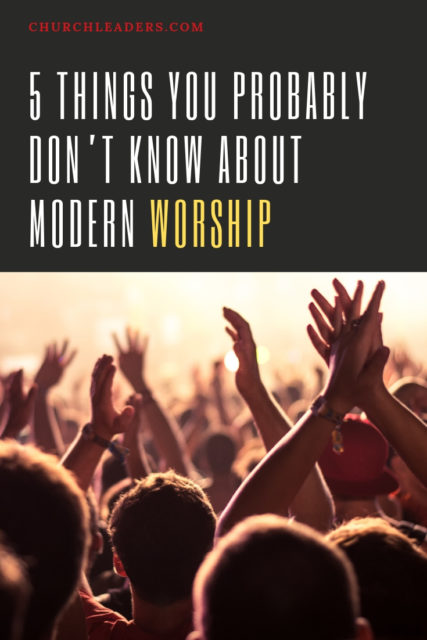5 Things You Probably Don’t Know About Modern Worship
It seems to be in vogue to predict the impending demise of modern worship, with some even suggesting we “kill megachurch worship.” The subject in question has been variously named “modern worship,” “contemporary worship,” and even the more direct and provocative aforementioned “megachurch worship.” While there have been a plethora of futurists and liturgists rushing to judgment, I am not certain if any of them worship regularly in a church that employs a modern worship style. And I am quite sure none of them are involved in leading either modern worship or megachurches.
So forgive my skepticism.
Before I go further, it’s worth my saying that if you know my writing over the past few years, you know I’ve been strong in challenging the contemporary worship movement (on formation; on reclaiming the mystery of faith through historic practices). You know that I believe in mining the old traditions of Christian worship, asking what they were doing and why and what we’ve changed and why. I believe with all my heart that “the way we worship becomes the way we believe.”
But I don’t believe careless critiques will help us.
The renowned social psychologist Paul Eckman wrote that research from a social scientist is less credible when their fieldwork cleanly validates their hypothesis. This is because the kind of experiments and research social scientists engage in are not easily repeated, and thus their biases are less easily held in check. If this is true of the biases even of researchers, what shall we say of the biases of bloggers (even—or especially—if they are liturgy professors)?
If one wants to prove the shallowness of modern worship, examples abound; but if you want to really understand and assess the subject, you need a more careful eye. And you must account for an insider perspective. What matters is not simply what the outside observer/blogger/professor thinks is going on; what matters is also what the pastor or worship leader says is going on, and what the worshiper is experiencing. (The latter is known as phenomenological perspective—the way people describe their experience of a thing.) If all we get are theoretical assessments from afar, we will evaluate modern worship without knowing if we are actually evaluating modern worship or our impression of it—which is almost always a caricature.
I’m new to the interdisciplinary approach to practical theology, but as a researcher I’m learning that we need more than theology to evaluate our practices. We need the tools of social anthropology to help us look properly at the thing we seek to evaluate. We need the lens of phenomenology to take seriously how people describe their experience of a particular practice. Only then can we engage in robust theological reflection.
What does it mean to take a closer look at modern worship?
It means doing “participant observation” in modern worship service and megachurches, not doing “drive-by” prediction blogs with non-falsifiable claims;
it means looking closely at song lyrics and comparing them with older hymns to test if we are guilty of romanticizing the old songs (Lester Ruth’s work suggests that we are);
it means listening to worship leaders to know how they pray and prepare for a worship service, before assuming that they are all aspiring rock stars trying to be cool;
it means listening to worshipers talk about spiritual experiences and encounters with God, instead of concluding that they are shallow consumers looking for a better religious product.
Some of my friends in vocational ministry may wonder why one would bother listening to someone else’s critique at all. Too many pastors dismiss the opinions of non-practitioners. Practitioners need theoreticians the same way that contractors need architects. The one building a church ought not ignore the one who studies its history and theology. So, I am not suggesting that we only listen to practitioners; but I am suggesting that critiques from non-practitioners be more accurate and nuanced. In short: If you want your theoretical critique of modern worship to be helpful to pastors and worship leaders, make sure you actually know and understand modern worship and/or megachurches. If you want to serve the church, you’ve got to love the church. And in order to love the church, you’ve got to know the church. The most helpful evaluations are from those who love us most and know us best. The most fruitful critiques are about the area of church practice that we know and love the best.
Here’s what you may not know about modern worship:
1. Not all megachurches are alike.
This should go without saying, but unfortunately, the broad assumption is that all large churches are the same. There is no such thing as “the megachurch”; there are megachurches, and each is a little different. Yes, there are broad similarities, but there are also significant differences. One example of undifferentiated study of megachurches is Kate Bowler’s landmark research on the prosperity gospel. In a journal article, she and her co-author fail to distinguish between the theology of Hillsong Church and that of Osteen’s Lakewood. Bloggers’ errors are more egregious. There is no recognition of the difference between the megachurch that adopts a “seeker” approach and therefore plays Top 40 covers in service, and the megachurch that believes in singing vertical worship songs to God to facilitate a genuine spiritual encounter. This is a mistake. We don’t assume all smaller churches are alike, so why the broad brush about ‘megachurches’?


